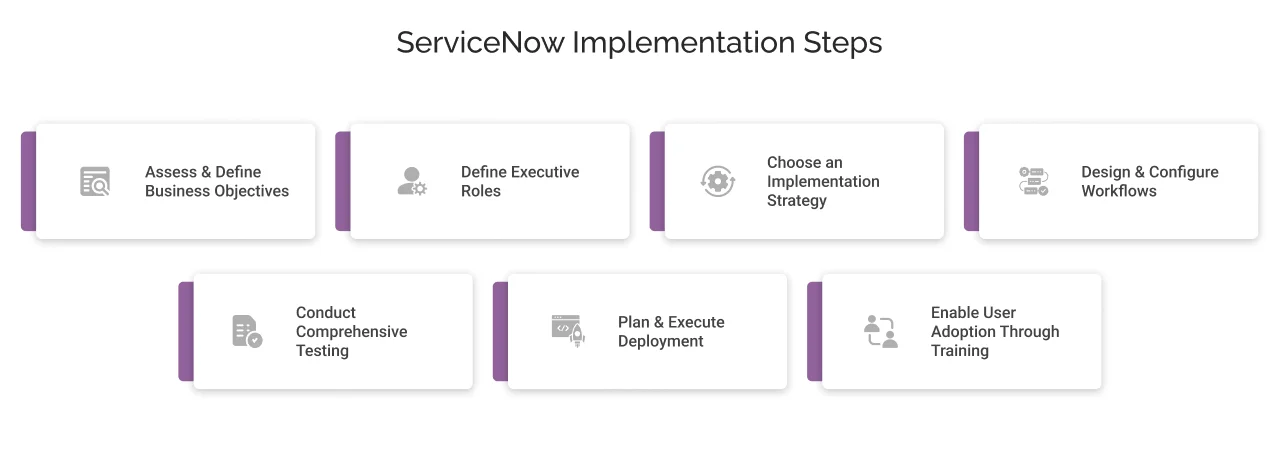Everything You Need to Know About ServiceNow Implementation
Table of Contents
ServiceNow implementation can fall short without the right strategy. Organizations often struggle with unclear roadmaps, budget overruns, integration complexities, and low user adoption.
So, how do you ensure a successful ServiceNow rollout?
Don’t worry! This blog uncovers pre-implementation considerations, a step-by-step ServiceNow implementation guide, and a pricing breakdown to help you prepare for success.
What is ServiceNow Implementation?
ServiceNow implementation refers to deploying, configuring, and customizing the ServiceNow platform to automate workflows (ITSM, HR, CSM, etc.) and unify business operations on a single cloud-based platform.
Why Consider Implementing ServiceNow?
ServiceNow helps businesses, from small to big enterprises, to:
- Streamline workflows: Automate IT, HR, customer service, and other business processes.
- Improve Visibility: Centralize operations for better decision-making.
- Enhance user experience: Enable self-service portals and AI-powered automation.
- Reduce operational costs: Minimize manual work and repetitive tasks.
However, a successful implementation requires careful planning and execution.
Pre-Implementation Considerations
Before moving into the implementation phase, it’s important to address the following key considerations:
Planning
Planning is the foundational phase where the strategy, scope, objectives, and resources for the ServiceNow implementation are defined. It includes:
- Understanding the organization’s strategic objectives from this platform.
- Deciding on the ServiceNow modules to implement, such as ITSM, ITOM, CSM, and HRSD.
- Defining the budget for licensing, ServiceNow consulting, training, and ongoing maintenance.
- Identifying potential risks (such as data migration challenges, resistance to change)
- Ensure contingency plans are in place in case of project delays or unforeseen situations.
Gathering Requirement
Requirement gathering is essential to define what changes you want to make. It includes:
- Map out the existing business processes and workflows.
- Prioritize the requirements (ensuring that critical business processes are prioritized in the initial implementation.
Set Up Instances
- Order Dev/Prod/Test instances from ServiceNow
- Configure basic company settings (such as company info, timezone, support email)
- Enable required plugins (ITSM, HRSD, CSM)
ServiceNow Implementation Steps
Here are the step-by-step implementation steps you can follow:


Step 1: Measure and Decide Your Business Goals
Having the surety of business goals and a checklist for implementation success (in terms of improving employee experience, reducing service outages, or something else) is necessary and, at the same time, challenging. You can document your objectives and target outcomes, like;
- Reducing IT support and maintenance costs (by 20%)
- Improve issue resolution speed (by 30%)
- Enabling self-service and automation (increase the usage by 25%)
Step 2: Define the Executive role
First, identify the right executive role (avoiding this may lead to conflicts in resource availability) who will have regular insights into company goals and have the authority to remove barriers to the success of implementation. Also, get their commitment as they have a number of priorities on their calendar.
Step 3: Bring in the ServiceNow Expertise
Implementing ServiceNow is like climbing a big mountain, you need experienced people proficient in the work. So, confirm you have already certified implementation specialists who understand ServiceNow products. If yes! Great, move on to the next step!
If you don’t have in-house experts, you can leverage the expertise of ServiceNow implementation services provider like Cyntexa. Their experts are well-versed in the implementation process with years of experience. They know how to avoid common mistakes and save a lot of time and effort.
Step 4: Take a Phased Approach
It is a big decision whether you are choosing a big bang or a phased approach. A big bang approach can be problematic for organizations that have a complex systems. At the same time, a phased approach incrementally adds features that typically yield better results.
Step 5: Map the Strong Foundation
This step is about laying a strong foundation that supports your growth and minimizes your headaches. This also means lower maintenance costs, easier adoption of ServiceNow features, and most importantly, more efficient, quicker initial implementation. So:
- Prioritizing OOTB (out-of-the-box) features provides you with a strong foundation.
- Further, you can communicate with the stakeholders if they require more complex features and workflows to ease their work.
- If you have a ServiceNow Architect already, then you can define the custom development needs (ensure it fulfils compliance needs and unique business requirements that OOTB can not handle.
This step is crucial as customization looks tempting, which can tailor things, but excessive customization is complex to maintain.
Step 6: Implementing Workflows
Business Rules: Implement custom business rules for automation of tasks, data processing, and notifications.
Workflows: Design workflows to automate approvals, task routing, and notifications using Flow Designer or Workflow Editor.
Client Scripts & UI Policies: Customize user interfaces and client-side behaviour using scripts and UI policies.
Step 7: Testing
Perform unit testing to validate individual configurations such as business rules, workflows, and UI elements.
Test the system’s performance, including load testing and scalability in the sandbox environment.
Step 8: Deployment to Production
- Deploy the system to the production environment.
- Migrate data from staging or development environments to production.
- Transition all configurations, scripts, and workflows to production.
Step 9: Provide Training For Success
After the ServiceNow implementation, your team needs training to navigate the complexities of the platform and ensure mission success. Implementing with the help of ServiceNow experts is not a one-time event, it’s an ongoing investment that extends far beyond the initial part.
Providing training to your end-users, admins, and maintenance team is crucial. It helps end users to use the platform effectively and the maintenance team to maintain the Now platform after go-live.
ServiceNow Implementation Cost
ServiceNow implementation cost varies depending on license price and implementation services (if you leverage expertise of a certified partner). Here’s a detailed breakdown:
Licensing Costs
Per-User, Per-Month: ServiceNow is not a one-size-fits-all platform; its pricing is flexible and structured on a per-user, per-month basis.
Module-based: The price depends on the module and required license type.
Getting a Quote
To understand the full pricing and accurate cost structure according to your specific business needs, you can:
- Contact ServiceNow-certified partners
- Contact ServiceNow for a detailed breakdown
- Review the contract carefully to avoid any inconvenience.
Ongoing Costs
Businesses should consider the ongoing ServiceNow costs when budgeting (such as license renewals, support fees, and additional modules costs).
Implementation Services Costs
The cost for ServiceNow implementation services is based on the specific requirements of businesses, scope of implementation, customization, integration, and deployment complexity.
For instance, you can leverage Cyntexa’s ServiceNow implementation services or also hire resources like admins, developers, QA’s, BA’s, project managers etc. at hourly rates.


Conclusion
A successful ServiceNow implementation requires strategic planning, clear objectives, expert guidance, and phased execution. Businesses can implement this tool efficiently and maximize ROI by focusing on OOTB functionality, prioritizing minimal customization, and proper user training.
If you need help with the rollout, we at Cyntexa, an official ServiceNow consulting and implementation partner are here to assist. Schedule a consultation call today!
Don’t Worry, We Got You Covered!
Get The Expert curated eGuide straight to your inbox and get going with the Salesforce Excellence.
AUTHOR
Shubham
Service Cloud, Salesforce Managed Packages
With over 5 years of experience, Shubham specialize in curating solutions on Salesforce Service Cloud, Nonprofit Cloud, Consumer Goods Cloud, Managed Packages, and ServiceNow ITSM. He designs and implements end-to-end service solutions that improve operational workflows and ensure seamless integration across enterprise systems. Shubham’s expertise lies in creating secure, efficient, and agile platforms tailored to unique business needs.


Cyntexa.
Join Our Newsletter. Get Your Daily Dose Of Search Know-How









